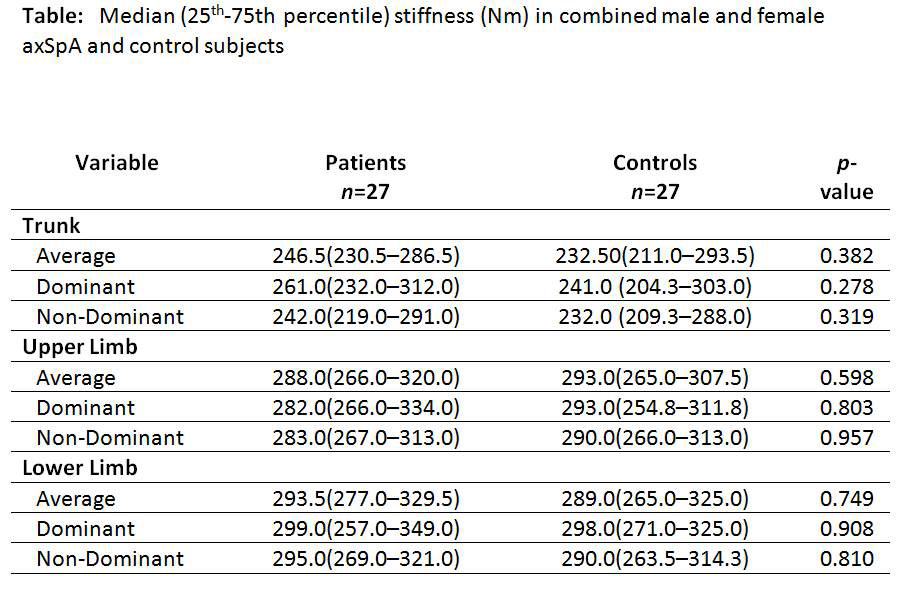Session Information
Session Type: Poster Session (Sunday)
Session Time: 9:00AM-11:00AM
Background/Purpose: An important mechanism regarding axial spondyloarthritis (axSpA) susceptibility and progression is the biomechanical concept, suspected from axial myofascial hypertonicity and stiffness in ankylosing spondylitis (AS). This pathway may promote local tissue microtrauma and contribute to immunological activation and subsequent bony fusion or ankylosis. The MyoSpA study tests the novel hypothesis of increased resting lumbar and appendicular (upper and lower limbs) myofascial tone/stiffness in axSpA patients compared to healthy controls (HC).
Methods: A cross-sectional study was conducted on 54 participants (18-50 years), 27 axSpA (according to ASAS criteria, with less than 10 years since symptoms onset) and 27 HC, matched by gender and age.
Muscle physical properties (stiffness, tone and elasticity) was quantified using the MyotonPro device. This myotonometer is a non-invasive device which applies a slight mechanical impulse to the skin via a probe, which is transmitted to the underlying soft tissue and muscle, and resultant oscillations are electronically recorded. Measurements were performed by a single tester, in three different body locations: lower lumbar (erector spinae myofascia at the L3-4 level), upper limbs (extensor digitorium, 5 cm below the elbow) and lower limbs (gastrocnemius 10 cm below knee), on both sides, after 10-minutes prone rest interval. Body composition was measured by octapolar multifrequency bioelectrical impedance analysis (InBody770). Physical activity was assessed by the International Physical Activity Questionnaire (IPAQ). Variables (except age, disease duration, BASDAI, BASFI) are presented as median (inter-quartile range). Non-parametric tests were used to compare groups.
Results: Mean (SD) age of the 27 axSpA patients was 36.8±7.4 years and the 27 HC was 36.3±7.8 (p=0.79), each having 18 males, 9 females. No significant difference occurred between groups in body mass index and physical activity. AxSpA patients had mean (SD) symptoms duration of 6.5±3.2 years, with BASDAI of 2.7±2.3 and BASFI of 0.9±3.1.
AxSpA and HC subjects showed no significant difference in muscle stiffness, tone and elasticity in the lumbar, upper and lower limbs, when the averaged values of combined male and female, right and left measurements were analyzed. AxSpA patients had slightly greater lumbar muscle stiffness [246.5 (230.5–286.5] than HC [232.5 (211.0–293.5], p=0.380. The difference was slightly greater on the dominant side [261.0 (232.0–312.0) vs 241.0 (204.3–303.0), p=0.28]. Gender had no influence on the results.
Conclusion: Young axSpA patients with mainly controlled disease, minor functional repercussion and short disease duration did not show a difference in muscle physical properties compared to HC. Further studies are needed to support the hypothesized biomechanical concept of increased resting lumbar myofascial stiffness in active axSpA patients.
To cite this abstract in AMA style:
Pimentel-Santos F, Neto A, Domingues L, Sardoo A, Rodrigues-Manica S, Pinheiro Torres R, Crespo C, Sepriano A, Ramiro S, Nair K, Costa J, Gomes-Alves P, Masi A, Branco J. Muscle Physical Properties in Young Adult Axial Spondyloarthritis Patients, the MyoSpA Study [abstract]. Arthritis Rheumatol. 2019; 71 (suppl 10). https://acrabstracts.org/abstract/muscle-physical-properties-in-young-adult-axial-spondyloarthritis-patients-the-myospa-study/. Accessed .« Back to 2019 ACR/ARP Annual Meeting
ACR Meeting Abstracts - https://acrabstracts.org/abstract/muscle-physical-properties-in-young-adult-axial-spondyloarthritis-patients-the-myospa-study/

